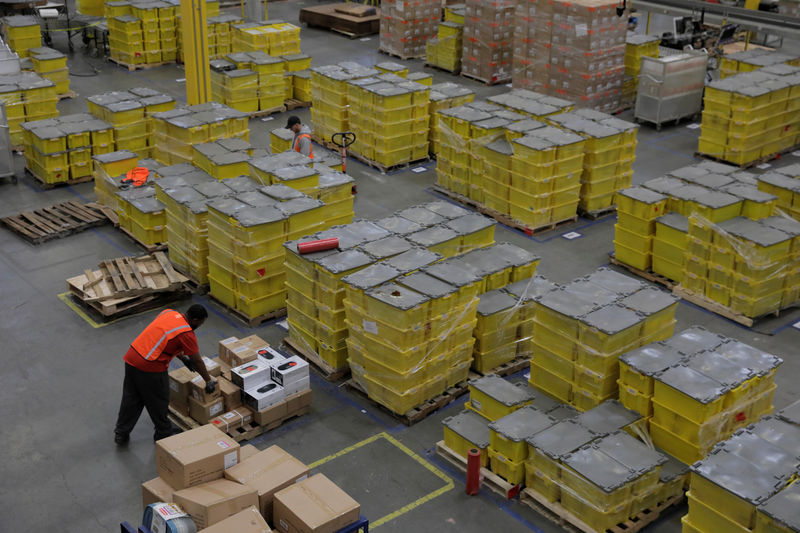This post was originally published on this site

Investing.com — Amazon’s position in e-commerce makes it a clear winner among retailers in the pandemic era. Last month, it reported a 37% gain in third quarter revenue, to $96.1 billion and profit of $6.3 billion.
That amounted to whopping earnings per share of $12.37, up from $4.23 a share the year earlier. Analysts had been expecting EPS of $7.41. That’s how big of a surprise the third quarter was.
But can Amazon.com Inc (NASDAQ:AMZN) maintain this momentum, especially given the stay-at-home era will eventually end, and people will start visiting malls and movie theaters once again.
Investing.com’s Liz Moyer argues that Amazon has plenty of room to grow, while Geoffrey Smith says these gains are unsustainable. This is Point/Counterpoint.
The Bull Case
Shares of the Seattle-based online retailing juggernaut are up 68% this year.
The consensus outlook for the whole year has EPS coming in at $34.91, up from $23.01 for 2019, a gain of around 52%. Revenue for 2020 is seen coming just over $379 billion, up 35% from last year.
Amazon has been aggressively spending on its infrastructure during the pandemic, setting aside $10 billion for the second through fourth quarters.
“The company does not want to be seen as benefiting too much from the pandemic,” VentureBeat recently wrote, noting its $5.2 billion in quarterly profit in the second quarter was the largest ever in its 26-year history and that it broke that record again in the third quarter.
It’s using the money to build out its fulfillment network, adding network capacity to meet higher demand from stuck-at-home consumers. It hired more people to run its fulfillment network, adding 250,000 permanent full-time and part-time workers in the third quarter and another 100,000 in October.
Chief Financial Officer Brian Olsavsky acknowledged the company’s capital spending on a recent conference call. “This has been a big year for capital investments, “ he said. “We expect to grow our fulfillment and logistics network square footage by approximately 50 percent this year.”
That doesn’t mean all the concerns about fulfillment have been addressed. Obviously the pandemic has seen restrictions on warehouse space and slower parcel delivery, which is problematic going into the holiday season.
“We’ll all be stretched and it’s advantageous to the customer and private companies for people to order early this year. But regardless of the order pattern, we’re gonna do our best to get the usual excellent service to our customers on pre-COVID levels,” the CFO told analysts last month.
Analysts see more growth from here, though Amazon is one of the most high-priced stocks. The average price target is north of $3,800, implying a 12-month return of 23%.
Deutsche Bank analysts said even before the earnings report that they remain bullish on the stock, seeing elevated growth as shoppers stick to online gift buying. Considering the severe problem with growing coronavirus cases around the country just weeks before the holidays, that may be an understatement.
The Bear Case
The bear case for Amazon rests to a large part on the fact that what the coronavirus has given, the pharmaceutical industry will take away. The pandemic may have accelerated a long-term shift toward remote working and shopping, but much of that will unwind the minute that people feel that they can go to the office, the mall and the movies safely.
The North American business, its most important one, was growing at a rate of 24% a year ago. In the third quarter of 2020, that rate had surged to 39%. That is unsustainable. Mean reversion will kick in and next year’s quarterly figures will have some very tough comparables. The stock trades at 91x trailing earnings. While not unusual in the context of a company that has consistently pursued growth over profit, that implies a growth rate that it will struggle to sustain, given that its main business has already reached globally systemic scale.
The market is also failing to price in the regulatory risks that loom ahead. The abusive practices detailed in the EU’s new antitrust charges look ominously like the same ones Amazon has repeatedly denied using in Congress. The risk is not only that Amazon is proved to be abusing a dominant position, but having lied about it too..
More broadly, it’s becoming increasingly clear that the peak power of big Internet platforms is -if not already behind us – then approaching very quickly (the crushing of Ant Group’s value by China is an example of the same phenomenon). The U.S. hasn’t faced such a concentration of economic power in private hands since Teddy Roosevelt’s day. At a time of massive unemployment and rising inequality – a phenomenon of which Amazon’s founder is the most egregious example – the super-profits of the FAANGS are politically unsustainable. The day of reckoning may be put off by a Congress divided against itself, but it will not be put off forever.
Europe’s governments in particular, having lost the taxes of all those stores bankrupted by Amazon over the last two decades, have already developed plans to tax Amazon and its peers on their sales, rather than their profits which are routinely magicked away to jurisdictions where the burden is lightest. Amazon’s provision for income taxes in the last quarter was a paltry 8.5% of its pretax profit. Faced with a monthly deficit currently running at $284 billion, the new U.S. administration may find it more expedient to join in soaking the super-profits of the FAANGS (and those who have invested in them), rather than defend them.
The latest lockdown measures will sauce the current quarter’s profit nicely, but it may well be downhill from there.

